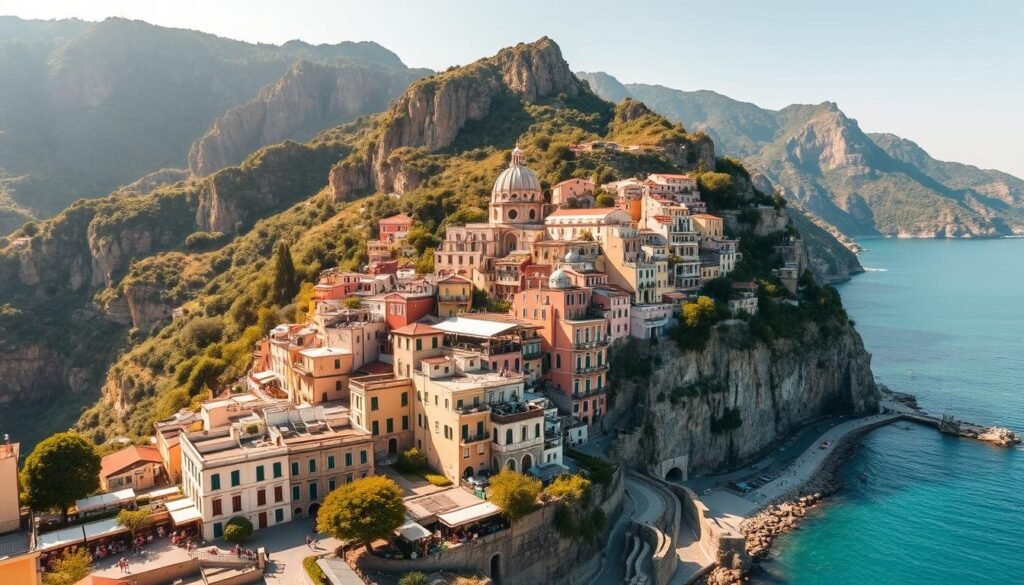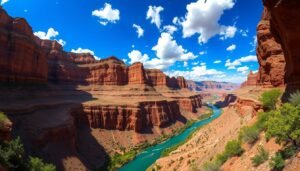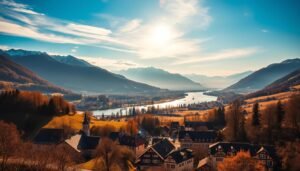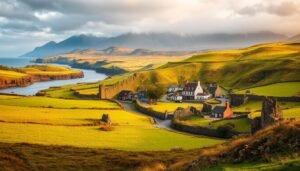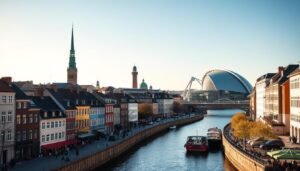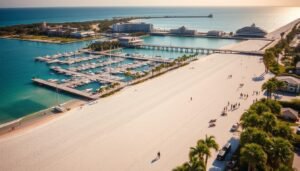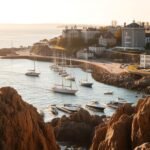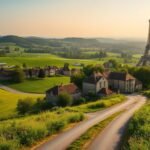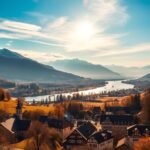Surprising fact: more than 60% of travelers say a single coastal view shaped their whole trip, and that’s exactly how my route unfolded.
I planned a trip that balanced city energy with seaside calm, mountain air and vineyard sunsets. I based my days on real timing: Amalfi Coast for about three days from Positano, Florence and Tuscany for several days, Cinque Terre for quick coastal walks, and longer stays at Lake Como and the Dolomites.
I wanted a trip that felt lived-in, not rushed. I watched how people moved through narrow streets, timed boat hops to Murano and Burano, and chose agriturismos for quiet nights between big museums and piazzas.
Use this list as a practical route map: logistics, ideal time spans, and why each destination earned a spot on my map. For seasonal notes and sample itineraries, see a concise guide I referenced from a trusted travel summary and another helpful roundup with timing tips.
Key Takeaways
- Plan days realistically: coastal towns often need 2–3 days; cities may need 3–5.
- Base in smaller towns like Positano or a Tuscan village to avoid constant backtracking.
- Mix busy cities with quieter regions for richer cultural and restful moments.
- Use trains for Liguria and car drives for rural Tuscany for smoother travel.
- Book boats and key site times in advance during peak season to save time.
How I choose the best places: balancing iconic cities, coastal views, mountains, food, and culture
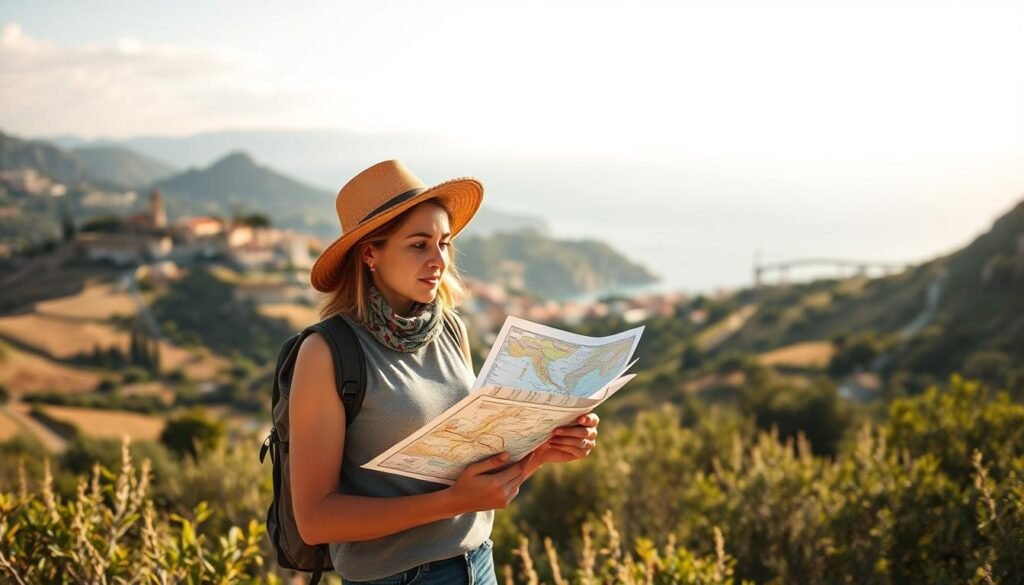
My selection grew from a simple rule: mix iconic sights with quiet corners where locals live.
Coming from the U.S., I budgeted realistic days so art-rich cities didn’t crowd out beaches, vineyards, or mountain air.
Practical flow mattered: I used high-speed trains for major routes, local trains for Cinque Terre, a rental car for Tuscany, and frequent ferries near Venice that run about every 30 minutes.
My trip goals from the U.S.: time, regions, and travel flow
- I matched each stop to ideal days: Amalfi Coast about 3 days, Florence 1–2 days plus 3 in Tuscany, cinque terre 1–2 days, Venice 3–5 days, Rome 3–5 days with a Vatican day.
- I stashed rest days and shorter segments—half-day hilltown visits—to keep energy up.
- I kept the sequence logical, north-to-south or vice versa, avoiding costly zigzags.
What “best” meant for me: art, history, villages, and real-life experiences
I defined value by mixing museums and cathedrals with small villages where I could sit and watch daily life. I used guided tour time for sites where a guide adds clear value and saved free time for neighborhood strolls and scenic overlooks.
“A good route lets you feel one italy, not just tick boxes.”
Best places in Italy to visit for coast-and-culture lovers: Amalfi Coast & Sorrento
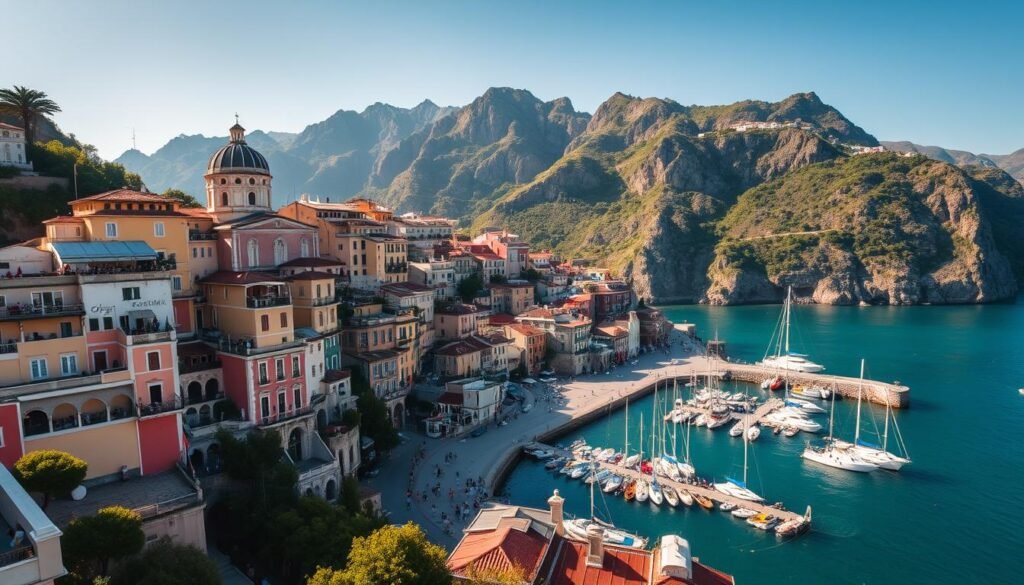
From cliffside terraces to ferry decks, the Amalfi region kept revealing small, unforgettable moments.
I based myself in Positano for three days, which gave easy access to Amalfi, Ravello, and Sorrento and made a Capri day trip simple and satisfying.
Highlights I loved
- Positano views from steep lanes, boutiques, and late-afternoon overlooks.
- Ravello’s Villa Rufolo — terraces that felt like a pause in cliffside life.
- Amalfi’s pebble beaches, Sorrento’s buzzy waterfront, and a quick ferry hop to Capri island.
How many days and when to go
I carved out about three days for this stretch. Mornings felt best for quieter streets; evenings brought golden light and lively dining.
To dodge crowds, I started early, finished dinners late, and left buffer time between towns.
Flavor of the region
The area smells of lemons and limoncello, and the food often tastes of sea and citrus. I loved people-watching here — vacationers drifting from beach clubs to pastel shops made every stroll feel one beautiful scene.
Amalfi Coast travel tips helped with ferry times and transit tricks.
“A coastline that rewards slow walking and open cameras.”
Cinque Terre’s cliff-hugging villages and national park trails

I found the coast’s rhythm: quick train hops, postcard views, and simple meals that lingered.
I spent 1–2 days exploring the cinque terre UNESCO World Heritage stretch of five villages—Monterosso, Vernazza, Corniglia, Manarola, Riomaggiore.
UNESCO World Heritage charm: Monterosso, Vernazza, Corniglia, Manarola, Riomaggiore
Highlights: Monterosso’s sandy beach, Corniglia’s hilltop views, and Manarola sunsets that felt like a painting.
My favorite experiences: Sentiero Azzurro, sea views, pesto, and train-hopping
Walking stretches of the Sentiero Azzurro felt like stepping into a postcard. Vineyards cling to cliffs and the sea glitters below.
- I split my time between short hikes and train-hopping the towns.
- I kept an eye on weather and trail closures, switching to trains when paths were muddy.
- Local espresso bars and small trattorias made each stop restful and real.
| Village | Top draw | Suggested time |
|---|---|---|
| Monterosso | Sandy beach | 2–4 hours |
| Vernazza | Harbor & pesto | 1–3 hours |
| Corniglia | Hilltop views | 1–2 hours |
| Manarola | Sunset harbor | 1–2 hours |
| Riomaggiore | Photo angles | 1–2 hours |
“By the time I left, it felt like I’d stitched together a mini coast-to-coast story across five cliffside towns.”
Florence & the Tuscan countryside: Renaissance art, hill towns, and vineyard life

Florence hit me like a concentrated lesson in art and sunlit roofs. I spent 1–2 focused days there, booking Uffizi and the Accademia ahead so I could see Michelangelo’s David without long waits.
I climbed Brunelleschi’s Dome for a panorama of terracotta and then walked across the Ponte Vecchio. The city’s narrow streets led me to small trattorias where simple food felt soulful and real.
After the city, I picked up a car and gave myself three slow days in the Tuscan region. Siena’s medieval alleys and San Gimignano’s towers felt like stepping into history.
Montepulciano rewarded a climb with Val d’Orcia views and Chianti in hand. I stayed at agriturismos where family-style dinners of pici pasta and rich olive oil turned ordinary things into lasting memories.
The timing worked: Florence for quick cultural intensity, then countryside time for relaxed rhythms and sunset cypress lanes. For any traveler who wants art, food, and quiet towns on a single trip, this combo sits high on my personal places visit list.
“I understood why the region makes people slow down and savor every small town square.”
Venice & the islands: Grand Canal nights, Murano glass, and Burano lace
![]()
I arrived in Venice and felt the city fold around me like a paper map, every canal a new line to follow.
I stayed 3–5 days so I could move slowly, catch island runs, and let evenings along the Grand Canal settle in. Boats ran roughly every 30 minutes, which made hopping to Murano and Burano easy and relaxed.
What felt magical and what didn’t: the night rides down the grand canal felt like a watercolor come alive, but prices and crowds were higher than elsewhere on my trip.
What felt magical to me (and what didn’t): romance, crowds, and costs
Murano’s glass-blowing and Burano’s lace gave texture to the visit. I loved simple rituals: a sunset vaporetto ride, espresso by a quiet bridge, cicchetti stops to balance splurges.
Don’t miss: vaporetto rides, canal-side strolls, and island boat times
- Plan for 3–5 days for a calm travel rhythm.
- Catch ferries roughly every half hour to the islands.
- Explore lesser-known sestieri for quieter daily life.
| Highlight | Why go | Suggested time |
|---|---|---|
| Grand Canal evenings | Romantic light and palazzi views | 1–2 evenings |
| Murano | Glass-blowing demos and workshops | 2–4 hours |
| Burano | Colorful houses and lace tradition | 2–4 hours |
| Lesser sestieri | Local cafés and calm canals | Half to full day |
“Venice’s city mood felt singular—water, light, and reflection everywhere I looked.”
Rome & Vatican City: streets steeped in history and world-class art

I found Rome equal parts theater and neighborhood—grand ruins and quiet alleys side by side. Stone layers show a dense timeline, and nearly every corner felt like a page from a long story.
Essential Rome moments: I traced the Forum and the Colosseum, lingered in famous piazzas, and rewarded long walks with gelato at random fountains.
Vatican City day: museums, masterpieces, and awe-inspiring halls
I saved one full day for the Vatican museums and St. Peter’s. The galleries felt like a world within a city, and the scale of the halls stopped me more than once.
How many days I’d plan for a first trip
- I set aside 3–5 days for Rome, which let me trace history and still enjoy slow evenings in piazzas.
- Each morning I made a short list so I could walk more and rush less.
- Food breaks—espresso, gelato, and a plate of cacio e pepe—kept energy up and moods bright.
“Rome reminded me that a city can be both an open-air museum and a lived neighborhood.”
The Dolomites: dramatic mountains, alpine lakes, and scenic hikes
![]()
I spent a week in the Dolomites letting jagged ridgelines set the pace for long, slow days. I drove up from Verona — about 2.5 hours — and based myself near trailheads so I could start early and chase light at overlooks.
My top spots:
Tre Cime di Lavaredo, Lago di Braies, Sella Ronda
Tre Cime di Lavaredo was my headline hike: a loop with spires that cut the skyline and nonstop dramatic views. Lago di Braies felt like a painting; I walked the shore while the water shifted from teal to deep emerald.
Sella Ronda gave a different rhythm. I cycled past peaks and small villages, then warmed up with hearty mountain fare at a hut. The area sits within a kind of protected national park mood, even when a major city is hours away.
When to go and what to pack for alpine weather
The weather changed on a dime, so I packed layers, a waterproof shell, sun protection, and grippy shoes for rock and scree. I carved out buffer days in case clouds rolled in, letting me swap hikes and still chase clear views when the sun returned.
“The Dolomites added alpine calm and a rugged finish to my route — equal parts wild and welcoming.”
Lake Como’s upscale calm: villas, gardens, and boat days

I slowed my pace around Como, letting villa gardens and shoreline light set the day’s rhythm.
I spent several days wandering Bellagio’s pretty lanes, lingering along Varenna’s waterfront, and enjoying Menaggio’s easy afternoons. A self-drive speedboat made the lake feel like a playground; I docked for lunch and chased golden light along the shore.
Bellagio, Varenna, Menaggio: where I wandered and why
Villa Carlotta’s gardens impressed me with layered blooms and wide views that reached up toward snow-dusted peaks. I penciled a short stop at Isola Comacina for a tiny island detour and quiet coves.
With Milan an hour away, Como slotted neatly into my list and gave a refined counterpoint to busier city days. I kept plans loose and let weather and mood decide whether I lingered in squares or hopped ferries.
“It felt like a lake made for wandering—beautiful boats by day, twinkling promenades by night.”
For a practical local guide, see my linked Lake Como write-up that helped shape my trip.
Lake Garda’s castles, thermal baths, and family-friendly towns

A short drive from Verona led me to a lake where castles, baths, and boats made easy afternoons memorable. I spent a restorative day or two here, balancing castle climbs with long strolls along the shore.
Sirmione stole the show: Scaliger Castle felt like a fairytale fortress and the local thermal baths were perfect after long days of travel. Cruising the lake by boat linked lakeside towns, letting me enjoy the views instead of watching timetables.
I explored Riva del Garda’s alpine-meets-lake mood and lingered in Malcesine and Garda for leisurely lunches on pretty promenades. As the region’s largest lake, Garda felt expansive yet easy to find quiet corners of life.
Sirmione, Riva, Malcesine — quick notes
- I made time for sunset on the shore; mountains cut the light into soft bands.
- Some boat routes stop at Isola del Garda, a tiny island with photogenic gardens.
- Accessible from Verona, the lake was a handy, family-friendly destination off a busy city schedule.
| Spot | Highlight | Suggested time |
|---|---|---|
| Sirmione | Scaliger Castle & thermal baths | Half to full day |
| Riva del Garda | Alpine views & watersports | Half day |
| Malcesine & Garda | Promenades and relaxed lunches | 2–4 hours |
| Isola del Garda | Island gardens and photo ops | 2–3 hours |
“Garda has a gentle mix of adventure and calm — perfect for a short escape.”
Puglia’s sun-drenched side of Italy: trulli villages, sea caves, and slow life
Sun and stone shaped my days in Puglia, where whitewashed lanes met rugged sea cliffs. The region felt rustic and unhurried, a warm side that stood apart from northern city rhythms.
Alberobello’s UNESCO-listed trulli and the beaches I loved
Alberobello’s trulli villages carried a clear world heritage charm: cone roofs, chalk-white lanes, and a compact layout that begged me to wander. I set aside a full day to walk those lanes and take pictures without rush.
Where the region won me over: Lecce’s Baroque streets and orecchiette
Lecce’s baroque streets glowed in warm stone. I poked into courtyards, sat for slow meals, and leaned into local food—orecchiette with tomato and ricotta forte tasted like home.
- Polignano a Mare’s sea caves turned a swim into an adventure and rewarded terrace seafood.
- Torre Lapillo and Pescoluse gave calm mornings on sand and late afternoons in town.
- Regional culture felt proudly local; small towns made the world feel close and intimate.
“Puglia showed me one beautiful contrast within the country — quiet towns, strong food, and a coastal mood that stayed with me long after I left.”
Bologna’s delicious streets: porticoes, piazzas, and the art of ragù
I spent a long weekend wandering Bologna’s porticoed lanes and tasting my way through lively markets. I stayed near Piazza Maggiore and let the day unfold between cafés, stalls, and late afternoons on shaded benches.
The city felt young and rooted at once. Students biked past medieval towers while locals queued for slow-cooked tagliatelle al ragù. I built a simple food circuit: morning pastries at Forno Brisa, a noon plate of ragù, then small bites at historic wine bars.
My foodie circuit: tagliatelle al ragù, wine bars, and vintage finds
I made time for Osteria del Sole—bring your own bread or antipasto and order a glass. The bar hums like a neighborhood living room; people drift in and out like regulars.
Climbing the Asinelli Tower gave me a terracotta skyline that turned gold at sunset. I wandered the Ghetto Ebraico for espresso stops and Frida Vintage for surprising finds. For more variety, I took short trains to nearby towns when I wanted a quick change of scene.
“This city earned a spot on my list because it felt genuinely lived-in, not just staged for visitors.”
- Slow travel rhythm: porticoes lead to cafés and markets where time stretches.
- Food focus: tagliatelle, crescentine, and lambrusco at buzzing wine bars.
- Easy add-ons: short train trips link Bologna with nearby towns for day breaks.
Conclusion
I measured success by how often I wanted to linger—an extra coffee, a longer walk, a sunrise hike.
My list balanced cities, coastlines, vineyards, and mountains so each destination earned its days. I gave 3 days for the Amalfi Coast with a Capri day, 1–2 days for Florence plus 3 in Tuscany, 1–2 for Cinque Terre, 3–5 for Venice, and 3–5 for Rome with a Vatican day.
The sequence mattered: ancient cities first, coastal chapters next, then countryside and alpine rest. Lakes and slower towns became my reset spots and the Dolomites offered quiet mountains and wide air.
Use this list as a guide, but leave room for food, sunsets, and random streets that felt like home. Travel with flexible days and you’ll find your own one Italy—full of small things that stay with you long after the trip ends.


